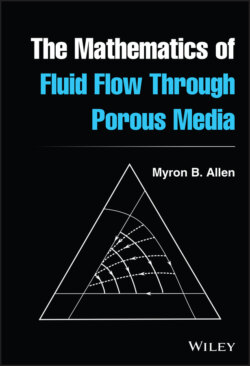Читать книгу The Mathematics of Fluid Flow Through Porous Media - Myron B. Allen III - Страница 25
2.3.3 The Navier–Stokes Equation
ОглавлениеExercise 2.7 Substitute the constitutive relationship (2.14) into the momentum balance and assume that gravity is negligible (for example, in a shallow horizontal flow) to derive the Navier–Stokes equation:
(2.15)
Here, is the kinematic viscosity, having dimension , and has the following representation with respect to an orthonormal basis:
Sir George Gabriel Stokes was an Irish‐born Cambridge professor who made extraordinary contributions to mathematical physics. Claude‐Louis Navier was a French mechanical engineer and professor of mathematics in the early nineteenth century.
Exercise 2.8 Find the correct pronunciation of “Navier.”
Owing largely to mathematical difficulties associated with the inertial terms, the Navier–Stokes equation remains a source of some of the most refractory unsolved problems in mathematics. Proving the existence and smoothness of solutions under general conditions remains one of six unsolved Millennial Prize Problems identified in 2000 by the Clay Institute for Mathematics [79].
To gauge the importance of inertial effects in specific problems, it is useful to cast Eq. (2.15) in terms of dimensionless variables—that is, variables having physical dimension 1. This technique filters out subjective effects associated with the analyst's choice of measurement units, mentioned in Section 1.3.
For concreteness, consider the flow of an incompressible Newtonian fluid in an infinite spatial domain surrounding a solid sphere having radius , as drawn in Figure 2.9. We examine a simplified version of this flow, called the Stokes problem, in Section 2.4. Assume that, as distance from the sphere increases, . Using the radius and the far‐field fluid speed as scaling parameters, define the following dimensionless variables:
By the chain rule, for any sufficiently differentiable function ,
Figure 2.9 Geometry of the Stokes problem for slow fluid flow around a solid sphere.
Here,
denotes the gradient operator with respect to the dimensionless spatial variable .
Exercise 2.9 Substitute these operators into the Navier–Stokes equation (2.15) and simplify to get the dimensionless Navier–Stokes equation:
(2.16)
where .
The dimensionless parameter in Eq. (2.16) is the Reynolds number, named after Irish‐born fluid mechanician Osborne Reynolds [128]. This number serves as a unit‐free gauge of the ratio of inertial effects to viscous effects and, heuristically, as an index of mathematical intractability. We associate the regime with slow flows in which viscous effects dominate those associated with inertia. When is much smaller than 1, it is common to neglect the inertial terms.
